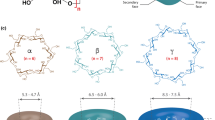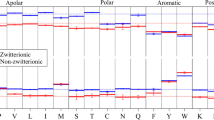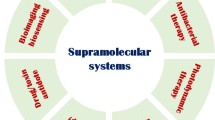Abstract
Cyclodextrins are commonly used as complexing agents in biological, pharmaceutical, and industrial applications since they have an effect on protein thermal and proteolytic stability, refolding yields, solubility, and taste masking. β-cyclodextrins (β-CD), because of their cavity size are a perfectly suited complexing agent for many common guest moieties. In the case of peptide-cyclodextrin and protein-cyclodextrin host–guest complexes the aromatic amino acids are reported to be the principal responsible of the interaction. For these reasons, we have investigated the inclusion properties of nine designed tripeptides, obtained permuting the position of two l-alanines (Ala, A) with that of one l-tryptophan (Trp, W), l-phenylalanine (Phe, F), or l-tyrosine (Tyr, Y), respectively. Interestingly, the position of the aromatic side-chain in the sequence appears to modulate the β-CD:peptide binding constants, determined via UV–Vis and NMR spectroscopy, which in turn assumes values higher than those reported for the single amino acid. The tripeptides containing a tyrosine showed the highest binding constants, with the central position in the Ac-AYA-NH2 peptide becoming the most favorite for the interaction. A combined NMR and Molecular Docking approach permitted to build detailed complex models, highlighting the stabilizing interactions of the neighboring amino acids backbone atoms with the upper rim of the β-CD.







Similar content being viewed by others
References
Aachmann FL, Otzen DE, Larsen KL, Wimmer R (2003) Structural background of cyclodextrin-protein interactions. Protein Eng 16:905–912
Aachmann FL, Larsen KL, Wimmer R (2012) Interactions of cyclodextrins with aromatic amino acids: a basis for protein interactions. J Incl Phenom Macrocycl Chem 73:349–357
Alderfer JL, Eliseev AV (1997) Complex of 4-Fluorophenol with alpha-Cyclodextrin: binding mode in solution is opposite to that in the solid state. J Org Chem 62:8225–8226
Bax A, Davis DG (1985) Practical aspects of two-dimensional transverse NOE spectroscopy. J Magn Reson 63:207–213
Benesi HA, Hildebrand JH (1949) A spectrophotometric investigation of the interaction of iodine with aromatic hydrocarbons. J Am Chem Soc 71:2703–2707
Bergeron RJ, Channing MA, Mcgovern KA (1978) Dependence of cyclo amylose substrate binding on charge. J Am Chem Soc 100:2878–2883
Bothner-by AA, Stephens RL, Lee JM, Warren CD, Jeanloz RW (1984) Structure determination of a tetrasaccharide - transient nuclear overhauser effects in the rotating frame. J Am Chem Soc 106:811–813
Braunschweiler L, Ernst RR (1983) Coherence transfer by isotropic mixing: application to proton correlation spectroscopy. J Magn Reson 53:512–528
Connors KA (1997) The stability of cyclodextrin complexes in solution. Chem Rev 97:1325–1358
Del Valle EMM (2004) Cyclodextrins and their uses: a review. Process Biochem 39:1033–1046
Delaglio F, Grzesiek S, Vuister GW, Zhu G, Pfeifer J, Bax A (1995) NMRPipe: a multidimensional spectral processing system based on UNIX pipes. J Biomol NMR 6:277–293
DeLano WL (2002) The PyMOL Molecular Graphics System. DeLano Scientific, San Carlos
Di Fabio G, Malgieri G, Isernia C, D’Onofrio J, Gaglione M, Messere A, Zarrelli A, De Napoli L (2012) A novel synthetic strategy for monosubstituted cyclodextrin derivatives. Chem Commun (Camb) 48:3875–3877
Dotsikas Y, Kontopanou E, Allagiannis C, Loukas YL (2000) Interaction of 6-p-toluidinylnaphthalene-2-sulphonate with beta-cyclodextrin. J Pharm Biomed Anal 23:997–1003
Ekka D, Roy MN (2013) Molecular interactions of α-amino acids insight into aqueous β-cyclodextrin systems. Amino Acids 45:755–777
Gelb RI, Schwartz LM, Cardelino B, Fuhrman HS, Jonson RF, Laufer GA (1981) Binding mechanisms in cyclohexaamylose complexes. J Am Chem Soc 103:1750–1757
Gibbs SJ, Johnson Jr. CS (1991) A PFG-NMR experiment for accurate diffusion and flow studies in the presence of eddy currents. J Magn Reson 93:395–402
Greatbanks D, Pickford R (1987) Cyclodextrins as chiral complexing agents in water, and their application to optical purity measurements. Magn Reson Chem 25:208–215
Griesinger C, Ernst RR (1987) Frequency offset effects and their elimination in NMR rotating-frame cross-relaxation spectroscopy. J Magn Reson 75:261–271
Hanessian S, Benalil A, Lafarriere C (1995) The synthesis of functionalized cyclodextrins as scaffolds and templates for molecular diversity, catalysis, and inclusion phenomena. J Org Chem 60:4786–4797
Hirose K (2001) A practical guide for the determination of binding constants. J Incl Phenom Macrocycl Chem 39:193–209
Huang CY (1982) Determination of binding stoichiometry by the continuous variation method: the Job plot. Methods Enzymol 87:509–525
Hwang TL, Shaka AJ (1995) Water suppression that works. Excitation sculpting using arbitrary waveforms and pulsed field gradients. J Magn Reson A 112:275–279
Iacovino R, Rapuano F, Caso JV, Russo A, Lavorgna M, Russo C, Isidori M, Russo L, Malgieri G, Isernia C (2013) β-Cyclodextrin inclusion complex to improve physicochemical properties of pipemidic acid: characterization and bioactivity evaluation. Int J Mol Sci 14:13022–13041
Job P (1928) Formation and stability of inorganic complexes in solution. Annal Chim Fr 9:113–203
Kahle C, Holzgrabe U (2004) Determination of binding constants of cyclodextrin inclusion complexes with amino acids and dipeptides by potentiometric titration. Chirality 16:509–515
Keller R (2004/2005) Optimizing the process of nuclear magnetic resonance spectrum analysis and computer aided resonance assignment. In: Swiss Federal Institute of Technology Zurich. ETH Zürich, Zurich. p 159
Koradi R, Billeter M, Wüthrich K (1996) MOLMOL: a program for display and analysis of macromolecular structures. J Mol Graph 14(51–55):29–32
Kumar A, Ernst RR, Wüthrich K (1980) A two-dimensional nuclear overhauser enhancement (2D NOE) experiment for the elucidation of complete proton-proton cross-relaxation networks in biological macromolecules. Biochem Biophys Res Commun 95:1–6
Li Z, Wan H, Shi Y, Ouyang P (2004) Personal experience with four kinds of chemical structure drawing software: review on ChemDraw, ChemWindow, ISIS/Draw, and ChemSketch. J Chem Inf Comput Sci 44:1886–1890
Lin M, Jayawickrama DA, Rose RA, Viscio JAD, Larive CK (1995) Nuclear magnetic resonance spectroscopic analysis of the selective complexation of the cis and trans isomers of phenylalanylproline by ß-cyclodextrin. Anal Chim Acta 307:449–457
Linde GA, Laverde AJ, Vaz de Faria E, Barros Colauto N, Faria de Moraes F, Zanin GM (2010) The use of 2D NMR to study b-cyclodextrin complexation and debittering of amino acids and peptides. Food Res Int 43:187–192
Loftsson T, Brewster ME (1996) Pharmaceutical applications of cyclodextrins. 1. Drug solubilization and stabilization. J Pharm Sci 85:1017–1025
Loukas YL, Vraka V, Gregoriadis G (1996) Use of a nonlinear least-squares model for the kinetic determination of the stability constant of cyclodextrin inclusion complexes. Int J Pharm 144:225–231
McAlpine SR, Garcia-Garibay MA (1996) Binding studies of adamantanecarboxylic acid and a Naphthyl-Bound beta-Cyclodextrin by variable temperature (1)H NMR. J Org Chem 61:8307–8309
McAlpine SR, Garcia-Garibay MA (1998) Studies of Naphthyl-substituted α-Cyclodextrins. Self-aggregation and inclusion of external guests. J Am Chem Soc 120:4269–4275
Mrozek J, Banecki B, Karolczak J, Wiczk W (2005) Influence of the separation of the charged groups and aromatic ring on interaction of tyrosine and phenylalanine analogues and derivatives with beta-cyclodextrin. Biophys Chem 116:237–250
Negi JS, Singh S (2013) Spectroscopic investigation on the inclusion complex formation between amisulpride and γ-cyclodextrin. Carbohydr Polym 92:1835–1843
Neuhaus D, Williamson MP (1989) The nuclear overhauser effect in structural and conformational analysis. VHC, New York
Pelta MD, Barjat H, Morris GA, Davis AL, Hammond SJ (1998) Pulse sequences for high-resolution diffusion-ordered spectroscopy (HR-DOSY). Magn Reson Chem 36:706–714
Pettersen EF, Goddard TD, Huang CC, Couch GS, Greenblatt DM, Meng EC, Ferrin TE (2004) UCSF Chimera–a visualization system for exploratory research and analysis. J Comput Chem 25:1605–1612
Rekharsky MV, Inoue Y (1998) Complexation thermodynamics of cyclodextrins. Chem Rev 98:1875–1918
Ritchie DW, Venkatraman V (2010) Ultra-fast FFT protein docking on graphics processors. Bioinformatics 26:2398–2405
Roy MN, Ekka D, Saha S, Roy MC (2014) Host–guest inclusion complexes of α and β-cyclodextrins with α-amino acids. RSC Advances 4:42383–42390
Rüdiger V, Eliseev A, Simova S, Schneider HJ, Blandamer MJ, Cullis PM, Meyer AJ (1996) Conformational, calorimetric and NMR spectroscopic studies on inclusion complexes of cyclodextrins with substituted phenyl and adamantane derivatives. J Chem Soc Perkin Transac 2:2119–2123
Saha R, Rakshit S, Pal SK (2013) Molecular recognition of a model globular protein apomyoglobin by synthetic receptor cyclodextrin: effect of fluorescence modification of the protein and cavity size of the receptor in the interaction. J Mol Recognit 26:568–577
Schneider HJ, Hacket F, Rüdiger V, Ikeda H (1998) NMR studies of cyclodextrins and cyclodextrin complexes. Chem Rev 98:1755–1786
Stancu AD, Hillebrand M, Tablet C, Mutihac L (2014) B-cyclodextrin derivative as chiral carrier in membrane transport of some aromatic amino acids. J Incl Phenom Macrocycl Chem 78:71–76
Szejtli J (1996) Inclusion of guest molecules, selectivity and molecular recognition by cyclodextrins. In: Osa JSaT (ed) Comprehensive supramolecular chemistry. Elsevier, Oxford. pp 189–203
Szejtli J (1998) Introduction and general overview of cyclodextrin chemistry. Chem Rev 98:1743–1754
Tang S, Kong L, Ou J, Liu Y, Li X, Zou H (2006) Application of cross-linked beta-cyclodextrin polymer for adsorption of aromatic amino acids. J Mol Recognit 19:39–48
Tarallo R, Accardo A, Falanga A, Guarnieri D, Vitiello G, Netti P, D’Errico G, Morelli G, Galdiero S (2011) Clickable functionalization of liposomes with the gH625 peptide from Herpes simplex virus type I for intracellular drug delivery. Chemistry 17:12659–12668
Wilkins DK, Grimshaw SB, Receveur V, Dobson CM, Jones JA, Smith LJ (1999) Hydrodynamic radii of native and denatured proteins measured by pulse field gradient NMR techniques. Biochemistry 38:16424–16431
Word JM, Lovell SC, Richardson JS, Richardson DC (1999) Asparagine and glutamine: using hydrogen atom contacts in the choice of side-chain amide orientation. J Mol Biol 285:1735–1747
Wüthrich K (1986) NMR of proteins and nucleic acids. Wiley, New York
Yang C, Liu L, Mu TW, Guo QX (2000) The performance of the Benesi-Hildebrand method in measuring the binding constants of the cyclodextrin complexation. Anal Sci 16:537–539
Yoe JH, Jones L (1944) Colorimetric determination of iron with disodium-1,2-dihydroxybenzene-3,5-disulfonate. Ind Eng Chem Anal Ed 16:111–115
Acknowledgments
The authors are grateful to Cristina Di Donato for useful discussion. This work was partially funded by M.I.U.R. Grants PRIN 2010 (to Roberto Fattorusso).
Conflict of interest
The authors declare that there are no conflicts of interest.
Author information
Authors and Affiliations
Corresponding author
Additional information
Handling Editor: D. Tsikas.
Electronic supplementary material
Below is the link to the electronic supplementary material.
Rights and permissions
About this article
Cite this article
Caso, J.V., Russo, L., Palmieri, M. et al. Investigating the inclusion properties of aromatic amino acids complexing beta-cyclodextrins in model peptides. Amino Acids 47, 2215–2227 (2015). https://doi.org/10.1007/s00726-015-2003-4
Received:
Accepted:
Published:
Issue Date:
DOI: https://doi.org/10.1007/s00726-015-2003-4




